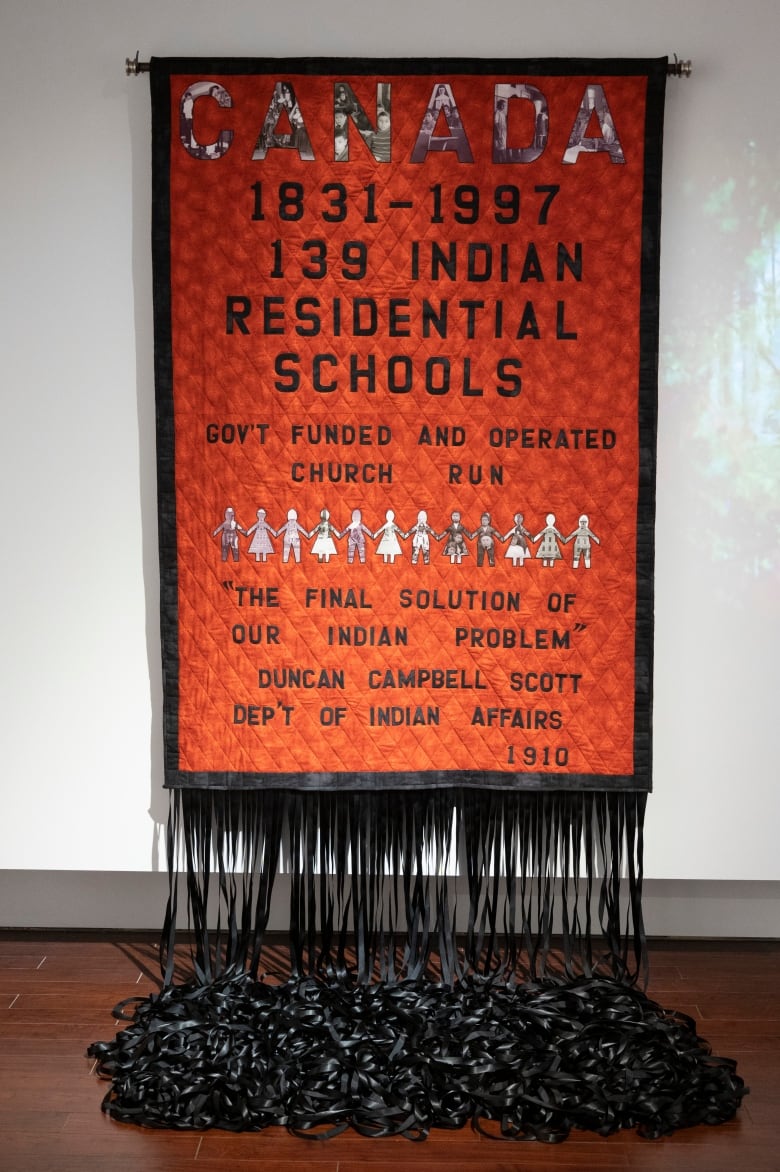Indigenous artists explore past, present, and future with new Drummondville exhibition | CBC News
Carla Hemlock spent over a year working on her latest piece of art responding to the discovery of hundreds of unmarked graves at sites of former residential schools.
“Like everyone else, it just took everything out of us to hear what was happening in Kamloops,” said Hemlock, a Kanien’kehá:ka textile and mixed media artist from Kahnawake, south of Montreal.
Hemlock debuted the work at DRAC, a contemporary art centre in Drummondville, Que., about 100 kilometres east of Montreal, at an exhibition titled I Hear Your Warm Whisper Through the Cold Mist. The exhibition also features the work of Inuk artist Glenn Gear and Wendat-Abenaki artist Christine Sioui Wawanoloath.
Hemlock’s work addresses the residential and boarding school systems that Indigenous youth were forced to attend in both Canada and the United States.
“There’s a lot of symbolism in this work,” she said.
A large quilt is at the centre of the installation, featuring intricate beadwork, hand-quilted dragonflies and appliqués of children in ribbon skirts surrounding a large turtle. The words “holding you tight until you are found” are written across the quilt.
Preliminary information obtained through ground-penetrating radar in May 2021 showed there could be as many as 200 unmarked children’s burial sites near the former Kamloops Indian Residential School, though the number could be much higher as only a small portion of the site was surveyed.
Hundreds of other possible unmarked graves have since been identified as searches are underway at other former school sites.
“The turtle was important because for me that’s who’s been caring for these children,” said Hemlock.

In Kanien’kehá:ka culture, creation of the Earth was on the back of a turtle — representing all of the natural world.
“They’re still out there in unmarked places. Who’s been caring for them and who’s been watching over them all of these years has been the natural world,” she said.
On each side of the large central quilt hangs a quilt representing the school systems that operated in Canada and the United States, incorporating archival photos and a quote from a politician that “sums up what the residential and boarding school was intended for.”
Hemlock worked with her son Raohseraha:wi Hemlock to project 10-minute videos between the quilts of silhouettes of former residential schools, sites, and landscapes of where missing children possibly are.
‘Re-establishing’ showcasing Indigenous art
“We’re really, really grateful to be the first centre to receive it,” said DRAC director Catherine Lafranchise.
“We feel like it’s a huge honour for us.”

Lafranchise who is new to the position, said it was important for her “re-establish” showcasing Indigenous artists.
For Inuk artist Glenn Gear, having the exhibition in a city like Drummondville means a lot as an opportunity to open doors in the community not only for his work but of other Indigenous artists.
“It gives people a glimpse into some Indigenous contemporary art practice,” said Gear, who is from Newfoundland and is now based in Montreal.
“I think it’s really important in terms of visibility and in terms of engaging a larger, wider audience of Drummondville.”
Gear has two large pieces in the exhibition. One called Papvik features a large whale tail created in fingerprints providing a frame for 13 photo collages done in dye sublimation on aluminum.
Each photo collage, he said, creates a jewel-like little world to explore, using his own material practice with sealskin, beadwork, and photo collage.

“I use a lot of photo archives from my region looking at early Inuit life and family life along the coast and mix those with my own archives, patterns and materials and creates this dreamlike space that weaves together the past, present, and maybe points towards a future,” said Gear.
The exhibition runs until Dec. 18.
For all the latest entertainment News Click Here

